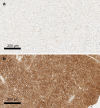Differences in [18F]FDG uptake in BAT of UCP1 -/- and UCP1 +/+ during adrenergic stimulation of non-shivering thermogenesis
- PMID: 33159596
- PMCID: PMC7648812
- DOI: 10.1186/s13550-020-00726-x
Differences in [18F]FDG uptake in BAT of UCP1 -/- and UCP1 +/+ during adrenergic stimulation of non-shivering thermogenesis
Abstract
Background: Brown adipose tissue (BAT) is a fat tissue found in most mammals that helps regulate energy balance and core body temperature through a sympathetic process known as non-shivering thermogenesis. BAT activity is commonly detected and quantified in [18F]FDG positron emission tomography/computed tomography (PET/CT) scans, and radiotracer uptake in BAT during adrenergic stimulation is often used as a surrogate measure for identifying thermogenic activity in the tissue. BAT thermogenesis is believed to be contingent upon the expression of the protein UCP1, but conflicting results have been reported in the literature concerning [18F]FDG uptake within BAT of mice with and without UCP1. Differences in animal handling techniques such as feeding status, type of anesthetic, type of BAT stimulation, and estrogen levels were identified as possible confounding variables for [18F]FDG uptake. In this study, we aimed to assess differences in BAT [18F]FDG uptake between wild-type and UCP1-knockout mice using a protocol that minimizes possible variations in BAT stimulation caused by different stress responses to mouse handling.
Results: [18F]FDG PET/CT scans were run on mice that were anesthetized with pentobarbital after stimulation of non-shivering thermogenesis by norepinephrine. While in wild-type mice [18F]FDG uptake in BAT increased significantly with norepinephrine stimulation of BAT, there was no consistent change in [18F]FDG uptake in BAT of mice lacking UCP1.
Conclusions: [18F]FDG uptake within adrenergically stimulated BAT of wild-type and UCP1-knockout mice can significantly vary such that an [18F]FDG uptake threshold cannot be used to differentiate wild-type from UCP1-knockout mice. However, while an increase in BAT [18F]FDG uptake during adrenergic stimulation is consistently observed in wild-type mice, in UCP1-knockout mice [18F]FDG uptake in BAT seems to be independent of β3-adrenergic stimulation of non-shivering thermogenesis.
Keywords: Brown adipose tissue; Infrared thermography; Standardized uptake value; Thermogenesis; Uncoupling protein 1; [18F]FDG.
Conflict of interest statement
The authors declare that they have no competing interests.
Figures








Similar articles
-
Dissociation Between Brown Adipose Tissue 18F-FDG Uptake and Thermogenesis in Uncoupling Protein 1-Deficient Mice.J Nucl Med. 2017 Jul;58(7):1100-1103. doi: 10.2967/jnumed.116.186460. Epub 2017 Jan 12. J Nucl Med. 2017. PMID: 28082439
-
18F-FDG PET/CT monitoring of β3 agonist-stimulated brown adipocyte recruitment in white adipose tissue.J Nucl Med. 2015 Jan;56(1):153-8. doi: 10.2967/jnumed.114.147603. Epub 2014 Dec 18. J Nucl Med. 2015. PMID: 25525187
-
β3-Adrenergically induced glucose uptake in brown adipose tissue is independent of UCP1 presence or activity: Mediation through the mTOR pathway.Mol Metab. 2017 Mar 30;6(6):611-619. doi: 10.1016/j.molmet.2017.02.006. eCollection 2017 Jun. Mol Metab. 2017. PMID: 28580291 Free PMC article.
-
Switching on the furnace: Regulation of heat production in brown adipose tissue.Mol Aspects Med. 2019 Aug;68:60-73. doi: 10.1016/j.mam.2019.07.005. Epub 2019 Aug 5. Mol Aspects Med. 2019. PMID: 31325458 Review.
-
UCP1: the only protein able to mediate adaptive non-shivering thermogenesis and metabolic inefficiency.Biochim Biophys Acta. 2001 Mar 1;1504(1):82-106. doi: 10.1016/s0005-2728(00)00247-4. Biochim Biophys Acta. 2001. PMID: 11239487 Review.
Cited by
-
In-vivo detection of white adipose tissue browning: a multimodality imaging approach.Sci Rep. 2023 Sep 19;13(1):15485. doi: 10.1038/s41598-023-42537-9. Sci Rep. 2023. PMID: 37726379 Free PMC article.
-
Xenon-enhanced computed tomography assessment of brown adipose tissue distribution and perfusion in lean, obese, and diabetic primates.Obesity (Silver Spring). 2022 Sep;30(9):1831-1841. doi: 10.1002/oby.23519. Epub 2022 Aug 1. Obesity (Silver Spring). 2022. PMID: 35912825 Free PMC article.
-
Imaging Adipose Tissue Browning using Mitochondrial Complex-I Tracer [18F]BCPP-EF.Contrast Media Mol Imaging. 2022 May 31;2022:6113660. doi: 10.1155/2022/6113660. eCollection 2022. Contrast Media Mol Imaging. 2022. PMID: 35694709 Free PMC article.
-
Longitudinal imaging of murine atherosclerosis with 2-deoxy-2-[18F]fluoro-D-glucose and [18F]-sodium fluoride in genetically modified Apolipoprotein E knock-out and wild type mice.Sci Rep. 2023 Dec 27;13(1):22983. doi: 10.1038/s41598-023-49585-1. Sci Rep. 2023. PMID: 38151517 Free PMC article.
References
Grants and funding
LinkOut - more resources
Full Text Sources
Research Materials

